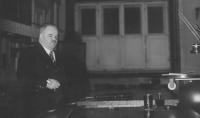The Year of Wolfke, Part 2. Atoms from light

Professor Mieczysław Wolfke delivering his lecture entitled "Scientific issues of stratospheric flights" at the Warsaw University of Technology, photo: National Digital Archives collection
Mieczysław Wolfke is one of the most acclaimed researchers and inventors associated with the Warsaw University of Technology. His ideas delighted the world, but they are not as well-known as they deserve to be. We want to change that!
The year 2022 is dedicated to Wolfke. In this way, the Polish Physical Society, Warsaw University of Technology, the Physics Committee of the Polish Academy of Sciences and the Polish Photonic Association commemorate a unique researcher and his achievements.
What is Wolfke's connection to the most outstanding physicists of the 20th century? More than you would expect, as it turns out.
New models and theories
In the early 20th century, physics was shaken by new theories. Max Planck, a German researcher, postulated that the energy emitted by hot bodies cannot assume random values, but is sent in small portions of a strictly defined size. Metaphorically speaking, it is impossible to pour just any amount of water into the glass, but only a finite number of spoons. The researchers wondered whether these small portions – quantums are some particles or just a limitation on the energy value of the light wave. It was Albert Einstein who first proved that these must be located in the space of light particles – photons, but the very idea of the molecular construction of light had already been considered by Isaac Newton two centuries earlier.
– ‘At that time, researchers had a major difficulty understanding the implications of these revolutionary ideas of Planck and Einstein,' recalls Krzysztof Petelczyc, PhD Eng. from the Faculty of Physics of the Warsaw University of Technology, and the Polish Physical Society, the coordinator of the celebrations of the Year of Mieczysław Wolfke 2022. – ‘They obtained mathematical equations consistent with measurements and experience. Now you had to push your imagination to the limit to explain how it would work. Trying to find the answer to the question "why?", they constructed models of "molecules" of light and matter, which no one could see, and over time they came up with a new model of atom and wave theory of matter particles.’
On equal terms
Debates on these topics took place during seminars in Zurich, Paris and Berlin. These meetings were also attended by Mieczysław Wolfke, an assistant professor, a lecturer at the Union University in Zurich and the local University. He published his ideas in the same scientific journals as more famous today physicists.
– 'He proved that light quantums can exist not only on their own, but also create complex molecules,' says Krzysztof Petelczyc, PhD Eng. – 'We find this idea in all the monographs describing the history of the shaping of quantum physics.
After World War II, it was not only Albert Einstein but also Louis de Broglie that Wolfke had interested in his theory, who in turn reported on the idea at the congresses of the Berlin and Paris Academies of Science.’
From Science to Economy
What is the significance of these discoveries today?
– 'Without the quantum theory of light, there would never have been lasers or photovoltaic cells, let alone the nascent quantum computer science,' says Krzysztof Petelczyc, PhD Eng. – ‘Wolfke always looked at scientific discoveries through the prism of the usefulness of their results in real terms for the economy or defense. When coming to Warsaw University of Technology a hundred years ago, he tried to work on discoveries, but at the same time cooperate with Polish companies, providing them with modern technologies in their production, stimulating their development in that way.’







